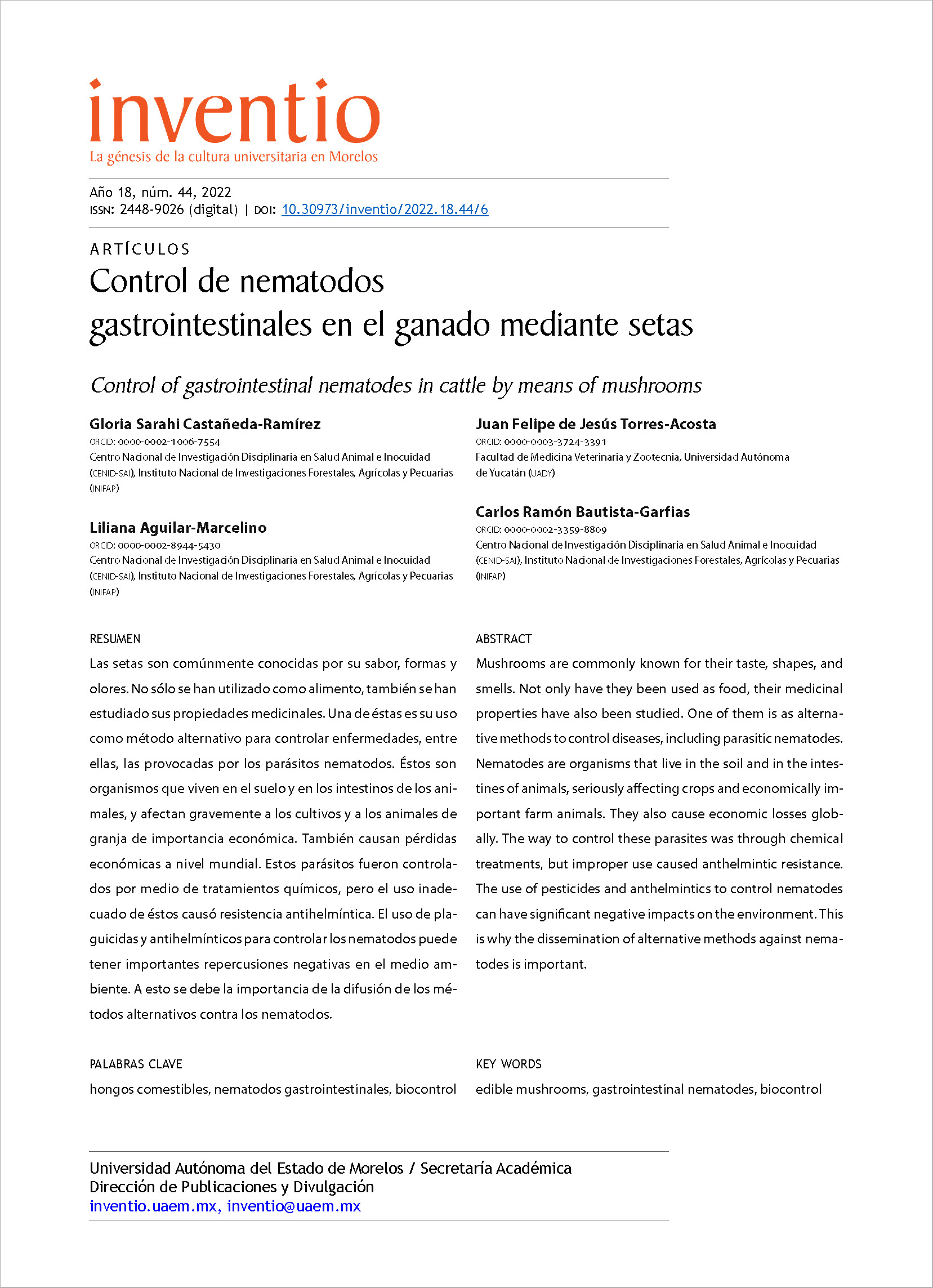Control de nematodos gastrointestinales en el ganado mediante setas
DOI:
https://doi.org/10.30973/inventio/2022.18.44/6Palabras clave:
hongos comestibles, nemátodos gastroinstestinales, biocontrolResumen
Las setas son comúnmente conocidas por su sabor, formas y olores. No sólo se han utilizado como alimento, también se han estudiado sus propiedades medicinales. Una de éstas es su uso como método alternativo para controlar enfermedades, entre ellas, las provocadas por los parásitos nematodos. Éstos son organismos que viven en el suelo y en los intestinos de los animales, y afectan gravemente a los cultivos y a los animales de granja de importancia económica. También causan pérdidas económicas a nivel mundial. Estos parásitos fueron controlados por medio de tratamientos químicos, pero el uso inadecuado de éstos causó resistencia antihelmíntica. El uso de plaguicidas y antihelmínticos para controlar los nematodos puede tener importantes repercusiones negativas en el medio ambiente. A esto se debe la importancia de la difusión de los métodos alternativos contra los nematodos.
Citas
Aguilar-Marcelino, L., Mendoza-de-Gives, P., Torres-Hernández, G., López-Arellano, M. E., Becerril-Pérez, C. M., Orihuela-Trujillo, A., Torres-Acosta, J. F. J. y Olmedo-Juárez, A. (2017). Consumption of nutritional pellets with Duddingtonia flagrans fungal chlamydospores reduces infective nematode larvae of Haemonchus contortus in faeces of Saint Croix lambs. Journal Helminthology, 91(6), 665-671. https://doi.org/10.1017/S0022149X1600081X
Bakir, T., Karadeniz, M. y Unal, S. (2018). Investigation of antioxidant activities of Pleurotus ostreatus stored at different temperatures. Food Sci Nutr. 6(4), 1040-1044. https://doi.org/10.1002%2Ffsn3.644
Barron, G. L. R. y Thorn, G. (1987). Destruction of nematodes by species of Pleurotus. Canadian Journal of Botany, 65(4), 774-778. https://doi.org/10.1139/b87-103
Chon, I. Y., Yu, E. J., Yu, S. C., Lee, J. Y. Jung, S. H. y Oh, T. J. (2018). The antibacterial effect of Pleurotus eryngii extracts on oral bacteria. Journal of Korean Society of Dental Hygiene, 18(1), 9-18. https://doi.org/10.13065/jksdh.2018.18.01.9
Contreras-Ochoa, C. O., Maza-Lopez, J., Mendoza de Gives, P., Aguilar-Marcelino, L., Mojica-Cardoso, C., Dimas-González, J., Fernández-Coto, D. L., Reyna-Figueroa, J., López-Arellano, M. E. y Lagunas-Martínez, A. (2022). Cell death induction by mycelium extracts from Pleurotus spp. on cervical cancer cell lines. Natural Product Research. https://doi.org/10.1080/14786419.2022.2045604
Guzmán, G. (1979). Identificación de los Hongos. Comestibles Venenosos Alucinantes y Destructores de la Madera. Limusa.
Hoste, H., Torres-Acosta, J. F. J, Alonso-Díaz, M. A., Brunet, S., Sandoval-Castro, C. y Adote, S. H. (2008). Identification and validation of bioactive plants for the control of gastrointestinal nematodes in small ruminants. Tropical Biomedicine, 25, 56-71. https://pubmed.ncbi.nlm.nih.gov/18414378/
Pérez-Cogollo, L. C., Rodríguez-Vivas, R. I., Basto-Estrella, G. S., Reyes-Novelo, E., Martínez-Morales, I., Ojeda-Chi, M. M. y Favila, M. E. (2018). Toxicidad y efectos adversos de las lactonas macrocíclicas sobre los escarabajos estercoleros: una revisión. Revista Mexicana de Biodiversidad, 89, 1293-1314. http://dx.doi.org/10.22201/ib.20078706e.2018.4.2508
Pineda-Alegría J. A., Sánchez-Vázquez, J. E., González-Cortázar, M., Zamilpa, A., López-Arellano, M. E., Cuevas-Padilla, E. J., Mendoza de Gives, P. y Aguilar-Marcelino, L. (2017). The edible mushroom Pleurotus djamor produces metabolites with lethal activity against the parasitic nematode Haemonchus contortus. Journal of Medicinal Food, 20(12), 1184-1192. https://doi.org/10.1089/jmf.2017.0031
Pino, P., Silva-Aguayo, G., Figueroa-Cares, I., Gerding-González, M., Loyola, P., Castañeda-Ramírez, G. S. y Aguilar-Marcelino, L. (2019). In vitro efficacy of edible mushroom Pleurotus ostreatus kumm extracts to Sitophilus zeamais motschulsky control. Chilean J. Agric. Anim. Sci., ex Agro-Ciencia, 35(3), 293-303. http://dx.doi.org/10.4067/S0719-38902019005000505
Rodríguez-Barrera, T. M., Téllez-Téllez, M., Sánchez, J. E., Castañeda-Ramirez, G. S., Acosta-Urdapilleta, M. L., Bautista-Garfias, C. R. y Aguilar-Marcelino, L. (2021). Edible mushrooms of the genus Pleurotus as biocontrol agents of parasites of importance for livestock. Scientia Fungorum, 52, e1375. https://doi.org/10.33885/sf.2021.52.1375
Sandoval-Castro, C. A., Torres-Acosta, J. F. J., Hoste, H., Salem, A. Z. M. y Chan-Pérez, J. I. (2012). Using plant bioactive materials to control gastrointestinal tract helminths in livestock. Animal Feed Science and Technology, 176, 192-201.https://doi.org/10.1016/j.anifeedsci.2012.07.023
Torres-Acosta, J. F. J., Mendoza, P., Aguilar-Caballero, A. J. y Cuéllar-Ordaz, I. A. (2012). Anthelmintic resistance in sheep farms: update of the situation in the American continent. Veterinary Parasitology, 189, 89-96. https://doi.org/10.1016/j.vetpar.2012.03.037
Urbancikova, I., Hudackova, D., Majtan, J., Rennerova, Z., Banovcin, P. y Jesenak, M. (2020). Efficacy of Pleuran (β-Glucan from Pleurotus ostreatus) in the Management of Herpes Simplex Virus Type 1 Infection. Evid Based Complement Alternat Med. 2020: 8562309. https://doi.org/10.1155/2020/8562309
Van der Heijden, M. G. A., Martin, F. M., Selosse, M. A. y Sanders, I. R. (2014). Mycorrhizal ecology and evolution: the past, the present, and the future. New Phytologist, 205, 1406-1423. https://doi.org/10.1111/nph.13288
Vieira, T. M., Fonseca, L. D. y Bastos, G. A. (2017). Control of Haemonchus contortus in sheep using basidiocarps of Agaricus blazei Murril. Veterinary Research Communications, 41(2), 99-106. https://doi.org/10.1007/s11259-017-9677-x
Zhao, S., Gao, Q., Rong, C., Wang, S., Zhao, Z., Liu, Y. y Xu, J. (2020). Immunomodulatory effects of edible and medicinal mushrooms and their ioactive immunoregulatory products. Journal of Fungi, 6, 269. https://doi.org/10.3390/jof6040269

Publicado
Cómo citar
Número
Sección
Licencia
Derechos de autor 2022 Gloria Sarahi Castañeda-Ramírez, Liliana Aguilar Marcelino, Juan Felipe de Jesús Torres-Acosta, Carlos Ramón Bautista-Garfias

Esta obra está bajo una licencia internacional Creative Commons Atribución-NoComercial 4.0.
Esta revista proporciona acceso abierto inmediato a su contenido, con base en el principio de ofrecer al público un acceso libre a las investigaciones para contribuir a un mayor intercambio global de conocimientos. Se distribuye bajo una licencia Creative Commons Reconocimiento-NoComercial 4.0 Internacional License.

